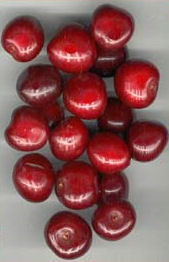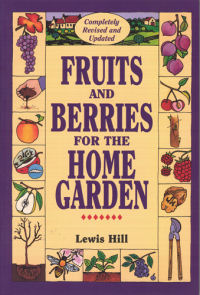
HOME
INTRO
SYMBOLS
ALMANAC
ECONOMY
GEOGRAPHY
STATE MAPS
PEOPLE
FORUM
NEWS
COOL SCHOOLS
STATE QUIZ
STATE LINKS
BOOK STORE
MARKETPLACE
GUESTBOOK
CONTACT US

Utah State Fruit: Cherry
Photograph: ARS photo by (Brian Prechtel)
Utah Law
The following information was excerpted from the Utah Code, Title 63G, Chapter 1, Section 601. All of Utah's state symbols are listed in section 63G-1-601. Below, we have only listed the entry regarding the official state fruit.
Title 63G General Government
Chapter 1 State Symbols and Designations
Section 601 State symbols.
63G-1-601. State symbols... (12) Utah's state fruit is the cherry.
Renumbered and Amended by Chapter 382, 2008 General Session
Sources...
Utah Code. Utah State Legislature. 2009. 1 April 2009
Shearer, Benjamin F. and Barbara S. State Names, Seals, Flags and Symbols: A Historical Guide Third Edition, Revised and Expanded. Westport, Conn: Greenwood Press, 3 Sub edition, 2001.

Utah State Fruit: Cherry
Credit: U.S. CDC
Additional Information
Utah State Fruit - The Cherry: Pioneer - Utah's Online Library.
Cherries: Good information about cherries from the FruitandVeggiesMatter website of the Center for Disease Control.
Sour, Tart or "Pie" Cherries: About sour cherries from What's Cooking America, website of cookbook author and culinary historian Linda Stradley.
Cherry Varieties: Utah State University Cooperative Extension.
Prunus avium (L.) L. (Sweet cherry): USDA, NRCS. 2004. The PLANTS Database, Version 3.5 (http://plants.usda.gov). National Plant Data Center, Baton Rouge, LA 70874-4490 USA.
Prunus cerasus L. (Sour cherry): USDA, NRCS. 2004. The PLANTS Database, Version 3.5 (http://plants.usda.gov). National Plant Data Center, Baton Rouge, LA 70874-4490 USA.
Prunus avium (L.) L. : Integrated Taxonomic Information System (ITIS) Here you will find authoritative taxonomic information on plants, animals, fungi, and microbes of North America and the world.
Prunus cerasus L.: Integrated Taxonomic Information System (ITIS) Here you will find authoritative taxonomic information on plants, animals, fungi, and microbes of North America and the world.
Prunus avium (Sweet cherry): CalPhoto photographs. The Biodiversity Sciences Technology group (BSCIT), a part of the Berkeley Natural History Museums at the University of California, Berkeley.
Prunus cerasus (Sour cherry): CalPhoto photographs. The Biodiversity Sciences Technology group (BSCIT), a part of the Berkeley Natural History Museums at the University of California, Berkeley.
State Fruit: Complete list of official state fruit.
More symbols & emblems: Complete list of official Utah state symbols.

Fruits and Berries for the Home Garden
by Lewis Hill
Fruits and Berries for the Home Garden, by Lewis Hill. 280 pages. Storey Publishing, LLC; Revised edition (January 4, 1992) With over 45 years of growing fruits, nuts, and berries, Lewis Hill is an authority. Basic enough for novices and comprehensive enough for more experienced growers, the book features recommendations about new, improved fruit cultivars, effective and environmentally sound advice on how to fertilize plantings and control pests and diseases, complete information about what fruit to grow and where, and recommendations on improving the soil, planting, pruning, thinning, and other year-round maintenance suggestions for harvesting, preserving, and storage.
The Backyard Orchardist: A Complete Guide to Growing Fruit Trees in the Home Garden, by Stella Otto. 250 pages. Ottographics; Rev Sub edition (January 1, 1995) For every gardener desiring to add apples, pears, cherries, and other tree fruit to their landscape here are hints and solid information from a professional horticulturist and experienced fruit grower. The Backyard Orchardist includes help on selecting the best fruit trees and information about each stage of growth and development, along with tips on harvest and storage of the fruit. Those with limited space will learn about growing dwarf fruit trees in containers.
Growing Fruit (RHS Encyclopedia of Practical Gardening), by Harry Baker, The Royal Horticultural Society. 192 pages. Mitchell Beazley; 3rd edition (March 1, 1999) Produced in association with the Royal Horticultural Society, the titles in this series, which have sold over a million copies worldwide, have become standard works of practical gardening reference. Each book is illustrated with easy-to-follow, step-by-step illustrations that clearly guide the reader through all the essential techniques of successful gardening.
The Organic Gardener's Handbook of Natural Insect and Disease Control: A Complete Problem-Solving Guide to Keeping Your Garden and Yard Healthy Without Chemicals, edited by Barbara W. Ellis and Fern Marshall Bradley. 544 pages. Rodale Books; Revised edition (May 15, 1996) An excellent handbook with entries for common fruits, flowering plants, vegetables, and trees. Each listing has information on disease and pest problems and tips on how to solve them without chemicals. Especially useful sections feature photos of garden insects and diseases.
The Omnivore's Dilemma: A Natural History of Four Meals, by Michael Pollan. 464 pages. Penguin Press HC, The (April 11, 2006) The bestselling author of The Botany of Desire explores the ecology of eating to unveil why we consume what we consume in the twenty-first century
In Defense of Food: An Eater's Manifesto, by Michael Pollan. 256 pages. Penguin Press HC, The (2008) In looking toward traditional diets the world over, as well as the foods our families-and regions-historically enjoyed, we can recover a more balanced, reasonable, and pleasurable approach to food. Michael Pollan's bracing and eloquent manifesto shows us how we might start making thoughtful food choices that will enrich our lives and enlarge our sense of what it means to be healthy.
Garden tools from Amazon.com!
 Custom Search
Custom Search



